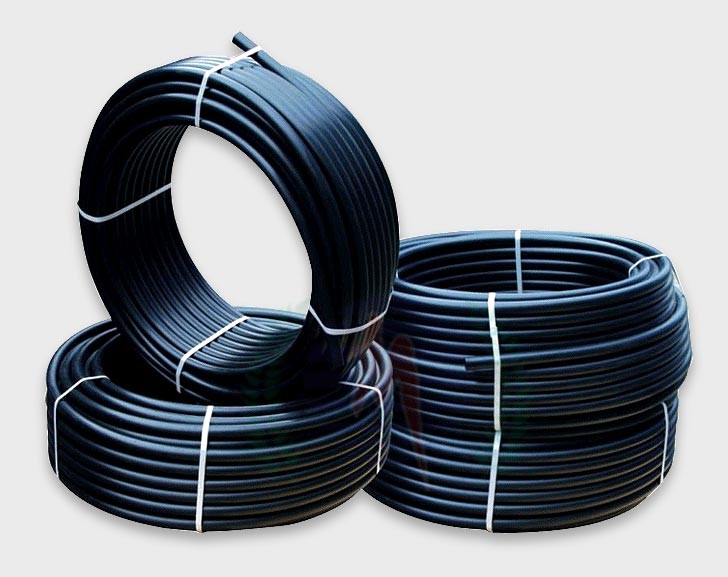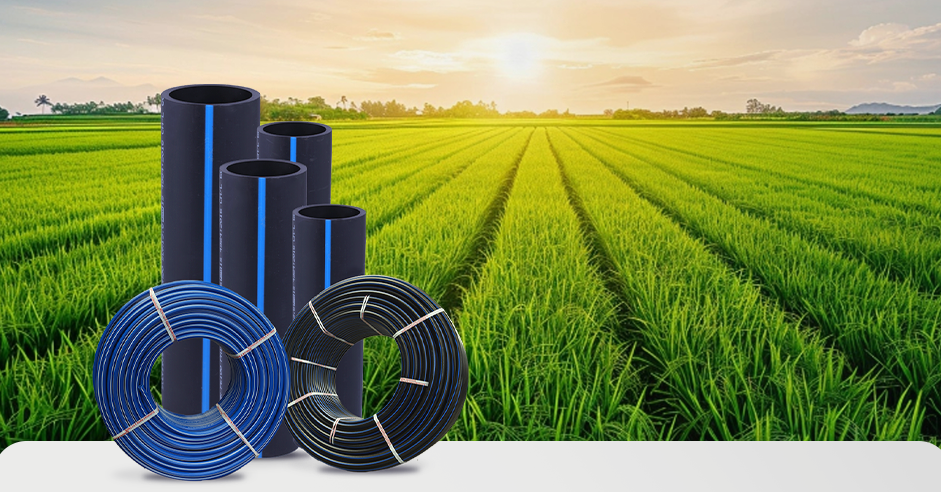Check Out the Manufacturing Process Behind High-Quality HDPE Pipeline and Its Applications
The production procedure of top quality HDPE pipes is elaborate and methodical. It begins with the choice of raw materials that improve efficiency. Following this, ethylene undergoes polymerization to form material, which is then formed via extrusion. Quality assurance is paramount, ensuring that the end product satisfies rigid criteria. Nevertheless, the trip of HDPE pipes doesn't end with manufacturing. Their applications across various sectors reveal a broader relevance worth checking out.
Comprehending HDPE: Qualities and Advantages

High-density polyethylene (HDPE) is a flexible thermoplastic known for its resilience and resistance to numerous environmental aspects. This product shows excellent tensile toughness, making it ideal for demanding applications. Its low-density structure adds to a light-weight item, helping with simplicity of managing and installation. HDPE additionally showcases exceptional resistance to chemicals, which minimizes destruction when revealed to severe materials.
The material's reduced dampness absorption even more improves its long life, making it excellent for use in pipelines and storage tanks. Additionally, HDPE is immune to ultraviolet (UV) radiation, ensuring that items keep their integrity even when subjected to sunlight. Its adaptability enables for the production of complex shapes without compromising strength. The eco-friendly nature of HDPE, commonly derived from recycled products, contributes to its allure, advertising sustainable methods in production. Generally, these buildings and benefits make HDPE a preferred selection for numerous industrial and customer applications.
Resources Choice for HDPE Production
The choice of resources for HDPE manufacturing is necessary to confirm the final product meets the preferred specifications and high quality standards. High-density polyethylene (HDPE) is mostly created from polymerized ethylene, stemmed from nonrenewable fuel sources such as gas or crude oil. The high quality of these feedstocks considerably affects the mechanical and thermal residential or commercial properties of the last HDPE.
Ingredients likewise play a significant role in improving HDPE's performance, consisting of antioxidants, UV stabilizers, and colorants, which enhance sturdiness and resistance to ecological variables. The choice procedure need to consider not just the chemical composition of the raw products but likewise their handling characteristics to assure efficient manufacturing.
The sourcing of raw materials should focus on sustainability and conformity with ecological regulations, as liable methods are vital in today's market. Ultimately, cautious resources option lays the structure for generating top quality HDPE pipelines suitable for varied applications.
The Extrusion Process: Forming HDPE Pipeline
The extrusion process plays an important duty fit HDPE pipes, starting with thorough product prep work methods that assure suitable circulation and uniformity. Equally important is the layout of the die, which straight influences the last dimensions and surface quality of the pipe. Together, these elements add significantly to the effectiveness and top quality of HDPE pipeline manufacturing.
Product Prep Work Strategies
Reliable production of HDPE pipes starts with thorough material preparation techniques, particularly the extrusion procedure. During this phase, high-density polyethylene material is first dried out to remove wetness, ensuring ideal flow features. The material is then fed into the extruder, where it undertakes heating and melting, transforming into a thick state. This home heating procedure is meticulously controlled to preserve the material's stability and performance. The liquified HDPE is compelled via a die, forming it into a continuous pipe type. Proper temperature monitoring throughout extrusion is necessary, as it directly influences the product's residential or commercial properties and the last product high quality. As soon as shaped, the HDPE pipe is cooled and cut to specified lengths, prepared for succeeding handling and applications.
Die Layout Relevance
Accuracy in die style plays a crucial duty in the extrusion procedure of HDPE pipes. The die serves as the last shaping tool, straight influencing the pipe's measurements, wall surface density, and surface area coating. A well-designed die guarantees uniform material circulation, minimizing issues such as abnormalities and weak places. The geometry of the die have to be maximized to suit the details homes of HDPE, including its viscosity and thermal actions during extrusion. Additionally, the cooling price of the product as it passes with the die can substantially impact the pipe's architectural honesty. Spending in advanced die modern technology is important for manufacturers intending to create premium HDPE pipelines that fulfill market criteria and consumer assumptions.
High Quality Control Measures in HDPE Production
Although numerous factors affect the top quality of HDPE pipeline production, efficient quality assurance measures are important to guarantee uniformity and dependability in the last item. Key top quality control methods consist of rigorous material assessment, verifying that the raw polyethylene satisfies established standards for purity and thickness. During the extrusion process, criteria such as temperature level, stress, and cooling time are closely kept track of to maintain dimensional accuracy and architectural honesty
Additionally, post-production testing check here is necessary; makers commonly carry out hydrostatic examinations to examine the pipeline's stamina and resistance to pressure. Visual evaluations for surface problems better boost quality assurance. Accreditation from pertinent requirements organizations, like ASTM or ISO, provides an extra layer of reliability. By implementing these thorough quality control steps, makers can decrease issues, improve performance, and ensure that the HDPE pipes meet the particular requirements of various applications, eventually bring about customer satisfaction and count on the item.
Applications of HDPE Pipeline Across Industries
HDPE pipes are made use of across various industries as a result of their resilience and convenience. In water circulation systems, they guarantee reliable delivery, while in wastewater management, they supply trustworthy solutions for waste transportation. Furthermore, farming irrigation networks gain from HDPE's resistance to rust and flexibility, making it a suitable choice for modern-day farming practices.

Water Circulation Equipments
A significant number of markets count on high-density polyethylene (HDPE) pipelines for efficient water distribution systems. Understood for their longevity and resistance to rust, HDPE pipes are commonly utilized in municipal water networks, farming irrigation, and commercial applications. Their light-weight nature helps with easy handling and installment, reducing labor prices and time. Furthermore, HDPE pipes can suit different pressure levels, making them suitable for both reduced and high-pressure systems. Texas hdpe pipe manufacturer. The flexibility of the product enables smooth assimilation right into existing framework, minimizing the requirement for considerable excavation. HDPE's resistance to chemical leaching warranties that the water provided stays safe and tidy, making it a suitable selection for keeping the top quality of drinkable water across different markets.
Wastewater Monitoring Solutions
Efficient water distribution systems likewise lead the way for ingenious wastewater management remedies, where high-density polyethylene (HDPE) pipelines play a substantial duty. Popular for their durability and resistance to deterioration, HDPE pipes are optimal for transporting wastewater in different setups. Their versatility enables for simple installation in complex atmospheres, reducing the need for substantial excavation. Additionally, HDPE's smooth indoor surface minimizes friction, enhancing circulation prices and effectiveness. These pipes are likewise resistant to chemical leaching, making certain that impurities do not compromise the surrounding atmosphere. Industries, districts, and therapy facilities progressively count on HDPE pipelines for their integrity and durability, making them a recommended choice for contemporary wastewater management systems. This flexibility highlights the crucial value of HDPE pipes across many applications.
Agricultural Irrigation Networks
Agricultural irrigation networks profit significantly from the usage of high-density polyethylene (HDPE) pipes, which provide efficient and trusted water shipment to crops. HDPE pipelines are light-weight, making them simple to transport and mount, while their flexibility enables numerous arrangements in diverse terrains. These pipes demonstrate outstanding resistance to corrosion, chemicals, and UV radiation, guaranteeing sturdiness in harsh farming settings. Furthermore, their smooth interior surface minimizes rubbing loss, maximizing water circulation and lowering energy expenses related to pumping. The durability of HDPE pipes, typically exceeding half a century, contributes to lower maintenance and substitute expenses. Farmers progressively count on HDPE pipelines to boost irrigation efficiency and promote sustainable farming practices, eventually leading to boosted plant returns and source preservation.

Future Fads in HDPE Pipeline Modern Technology
As the need for sustainable and effective facilities grows, innovations in HDPE pipeline modern technology are positioned to change numerous industries. Emerging patterns include the integration of wise innovations, such as sensing units and IoT capabilities, which assist in real-time monitoring of pipeline conditions, minimizing upkeep expenses and avoiding leakages. In addition, the growth of innovative production methods, such as 3D printing, is making it possible for the production of facility, tailored pipe designs that satisfy details job demands.
The emphasis on recycling and circular economic climate methods is driving the innovation of HDPE pipes made from recycled materials, improving sustainability. Improved jointing methods, such as electro-fusion and mechanical fittings, are also boosting installment efficiency and integrity. The growing focus on ecological regulations is pushing makers to adopt greener production processes, making sure that HDPE pipes not only meet market requirements however likewise promote a more lasting future for framework development.
Regularly Asked Concerns
How Does HDPE Contrast to Other Plastic Materials?
HDPE outshines numerous various other plastic products relating to resilience, chemical resistance, and versatility. Its low thickness and high tensile stamina make it optimal for various applications, commonly going beyond alternatives in both efficiency and long life.
What Are the Environmental Effects of HDPE Manufacturing?
The ecological impacts of HDPE manufacturing consist of greenhouse gas emissions, energy usage, and potential pollution from manufacturing processes. Furthermore, inappropriate disposal can result in dirt and water contamination, increasing issues regarding lasting ecological effects.
Can HDPE Pipeline Be Reused?
Yes, HDPE pipes can be recycled. Several facilities accept used HDPE for handling, changing it into brand-new products. This reusing contributes to sustainability initiatives, decreasing plastic waste while conserving resources and power in the manufacturing cycle.
What Is the Life Expectancy of HDPE Pipeline?

Exactly How Do Temperature Variants Affect HDPE Pipeline Performance?
Temperature level variants significantly influence HDPE pipe efficiency, influencing flexibility and toughness. Heats can bring about softening, while reduced temperatures may trigger brittleness, eventually influencing the pipeline's durability and suitability for various applications in diverse environments.